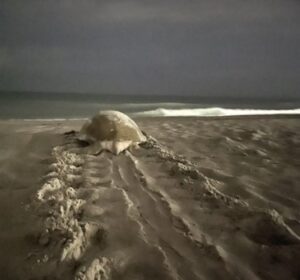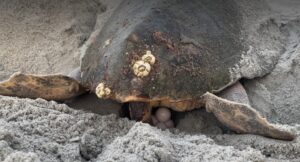Posted by Kasey | 10.24.2023 | Conservation, Karen Beasley Sea Turtle Hospital, Sea Turtle Camp, Turtle Talk
Sea Turtle Nesting
 From mid-May to late August as the months turn warmer, sea turtles come ashore in North Carolina to lay their eggs! The primary turtle that utilizes our beaches is the Loggerhead. As the sun sets
From mid-May to late August as the months turn warmer, sea turtles come ashore in North Carolina to lay their eggs! The primary turtle that utilizes our beaches is the Loggerhead. As the sun sets  and the moon rises, these amazing creatures leave the protection of the ocean to crawl up the sand to the dunes to choose a spot to lay their eggs.
and the moon rises, these amazing creatures leave the protection of the ocean to crawl up the sand to the dunes to choose a spot to lay their eggs.
The next step in her process is to dig a body pit. She will use her powerful front and back flippers to dig out a bit of the sand around her body. Then using only her back flippers, she will start to dig her egg chamber. The amount of precision she uses as she digs deeper and deeper into the sand leaves you in awe because she will dig about an arm’s length deep and the shape will be an upside-down light bulb. The walls of the nest chamber will be solid to provide protection for the eggs she is about to lay.
Once she has dug her chamber to her liking, the egg-laying begins. She will settle over the opening of her egg chamber so her cloaca can drop the eggs into the nest. She can lay one egg or multiple eggs at a time. You might be wondering why they don’t break as they drop into the nest on top of each other. The reason is that they are soft and leathery, not hard like a chicken egg. This allows the eggs to handle the drop without breaking and the impact of eggs still to come on top of them. She may lay 60 eggs, or she may lay 130 eggs, it really depends on the sea turtle.
After she has finished laying her last egg, she begins to cover her eggs up for more protection. At first, she will use her back flippers to really pull the sand over the exposed eggs. She will then use both her front and back flippers to fully camouflage her nesting area. As soon as she is satisfied with her work, she will turn around and head back down to the water.
As she crawls back into the ocean, she will only leave behind her crawl and the moved sand from where she nested. She will not return to her nest but may return to the beach to lay another nest in a couple of weeks. This past year North Carolina had over 1,700 nests on our beaches! All summer long volunteers across the state work tirelessly to protect the nests laid by these amazing species and we tip our fins to them!



 Marine Bio
Marine Bio SCUBA
SCUBA Travel
Travel School Groups
School Groups Sign Up
Sign Up CONTACT
CONTACT CAMPS
CAMPS ABOUT
ABOUT